Eric Hunting [hunting@tigger.jvnc.net] 5/2001
For the past few months I've been pondering a new and relatively simple plan for founding a marine colony using an approach based on the more conventional approaches to real estate development. I have also been working on a series of 3D modeled sketches illustrating a number of different designs and construction approaches for an initial at-shore seed structure based on a modular PSP. This isn't necessarily an 'easy' plan and it still poses some challenges but it's a fairly straightforward concept, one consistent with economic realities, normal business conventions, and which makes founding a marine colony not very different from founding any community on land.
Before I explain this plan, it would be a good idea to briefly go over TMP's approach to developing Aquarius. Because his book lacked the space to get into any nuts & bolts detail, Marshal Savage's plan for starting Aquarius was easily overlooked. Some have even thought that TMP offered no definitive plan for how Aquarius would be developed. In fact, it did but recognizing it was contingent on reading between the lines a little, understanding the scale of the development stages described in the book, and extrapolating from this the general manner in which stages supported each other. Often the stages of TMP have been imagined to be a discrete set of communities and projects that built one upon the other. But in fact what TMP describes are prototypes of communities intended to be duplicated in large numbers by the end of a given stage. Understanding this is critical to understanding how Aquarius -the first of a whole family of similar marine colonies- was supposed to be produced from the Aquarius Rising stage.
How Aquarius was supposed to be built:
The key complication with Aquarius from a development standpoint was its need for sheltered water in order to facilitate its construction. The work of seacreting and assembling large static float structural units could not be easily done in rough open water and thus it would not be possible to fabricate the structural components Aquarius was to be built with at the colony's intended site without some kind of shelter. The solution to this dilemma was the breakwater ring. During construction the ring would provide the primary shelter inside which one would fabricate the components of the central island, while at the same time providing temporary residence and work space for the initial inhabitants and work crews and points for mooring of work ships. But the catch was that this ring constituted one of the largest structural features of the colony and needed to be pre-fabricated and moved to the site, its own components being fabricated in other sheltered locations. This presented a gigantic up-front expense for the community. How would one afford this?
The answer to that question apparently lay in the number of Aquarius Rising communities. If one reads TMP carefully one notes that Savage intended the creation of hundreds of Aquarius Rising colonies, not just the one prototype. Each one was intended to become a regional HQ for different FMF groups around the globe. And each one was intended to have its own small secrete fabrication capability with, hopefully, its own OTEC. If each of these communities had, simultaneously, built just one module for the Aquarius breakwater ring then the parts for that ring could have been completed in just a year and the whole structure assembled in a couple months. For each individual AR community the cost of building one ring module would be relatively small and easily supported by the profits of their local mariculture and tourism revenue. And if most of these communities had their own OTECs and secrete fabrication equipment then simply by relocating a half dozen of them to the fledgling Aquarius the necessary on-site power production would be immediately covered at little additional cost and there would be sufficient initial residents and construction equipment on site to support its subsequent development. Thus the high initial up-front expense of getting Aquarius started would be be spread over this large number of Aquarius Rising communities.
But this strategy has some problems. Coastal real estate is much rarer and more expensive around the world today than TMP seemed to imply, particularly property like that Savage imagined for Aquarius Rising and near the regions where the initial FMF membership is most concentrated; the US and Europe. OTEC, while an off-the-shelf technology now, has also proven to be a much more expensive than TMP anticipated making its use in small communities a great challenge. We have also come to realize that people are much more reluctant to take chances on living in small communities in remote and relatively primitive locations with poor transportation and communication links. While we might readily find cheap locations just as Savage envisioned in poorly developed places around the globe, how many Americans and Europeans are really going to abandon their comfortable suburban lives and take a chance moving there? These little communities would need to start out in a very robust state to overcome such concerns, which would make them much more expensive. Furthermore, remotely located communities are very isolated from markets for their products, making it harder for them to sustain themselves economically the farther they are from major urban centers. This is why remote island communities today have a hard time surviving in an age when the packet steamer and the flying boat are long gone and huge populations are needed to support container ship and air liner transport. We are still in an age of relatively primitive transportation technology. There are still vast gaps in capability in the fabric of available transportation, particularly in the area of long range, low cost, moderate payload, high speed transport. Without such transportation remote communities are doomed to remain tiny, struggling, and primitive. Logistically, it would have been better for Savage to have put the Aquarius Airship in a development phase all its own _preceding_ Aquarius Rising. The transportation capability it promised was probably more critical to the idea of new community development than either OTEC or secrete technology.
Simplifying Aquarius:
When I learned of Float Inc.'s PSP technology several years ago I realized that this offered us a way to radically simplify the whole approach to marine colony development because of three things. First, PSPs eliminate the need for sheltered water to fabricate the colony's structure and thus eliminate the pre-requisite of a large breakwater ring. A PSP is stable on the open sea without a breakwater and once such a platfrom has reached a signficant size it can serve directly for mooring work vessels and can fabricate its modules on-board without any unusual equipment, dropping them into the water on its self-sheltered side and winching them into place. Next, PSPs are self-mobile, using integral electric azimuth thrusters -just like those used on cruise liners today- for station-keeping and slow propulsion. One doesn't need an elaborate anchor system to keep a colony in one place no matter how large it might be and one is not limited to any one location for a colony. It could be built in one place then move itself -without tow ships- to another. It could even travel the globe, moving with the change in seasons if residents so wished. Unlike other open sea structural systems, PSPs have a fairly shallow draft and so they can readily move between open sea and shallow sheltered bays, whereas other platform systems are often limited to one or the other. Finally, PSPs are an off-the-shelf technology based on off-the-shelf materials. One needs no new research and development to invent the necessary technology to create a marine colony. It's all here and now, ready to go. With PSPs Aquarius becomes a straightforward structural engineering and architectural design project.
All this added up in my mind to the conclusion that a marine colony could be built incrementally starting from a very small size, just like communities on land. An oversized concrete house boat in a conventional marina could, in time, turn into a colony on the open sea just as a homestead on the edge of wilderness might eventually grow into a city. There is no need for a separate AR stage preceding the Aquarius stage. It can, instead, merge with the Aquarius stage because every AR colony built with this technology would have the potential to evolve directly into a full scale marine colony. Aquarius Rising can be just what its name implies.
Furthermore, using PSPs and conventional concrete there is no need to engage in as much R&D work as originally planned thus a starting community doesn't absolutely need the special features of the lagoon locations Savage envisioned. One could quite simply start out in a marina or dockside right on the waterfront of any existing coastal community or out free-floating in any sheltered bay. The key obstacles with the original AR plan are eliminated since a fledgling colony can be started most anywhere in convenient proximity to the majority of FMF members and existing transportation networks. Many different modes of use can be explored specific to the needs and conditions of the location rather than just relying on mariculture as the one and only industry. Total self-sufficiency for the fledgling community and the use of OTEC systems is not important until it has reached a significant size and by remaining in proximity to an urban center initial residents suffer no compromises in quality of life, employment opportunity, health care services, education, etc. In essence, the inhabitants of this kind of AR community would be living no differently from people living in the many house boat communities, river barge communities, or barge-based condominium buildings, except for one thing; AR would be constantly growing and evolving toward independence of the shore.
A different economic model:
This different approach would call for a different economic strategy. Savage's AR concept was very much akin to the traditional remote agrarian-focused eco-village. Its economic sustainability was dependent on tourism, alternative forms of agriculture, mariculture, and other sea-sourced products such as seacrete related materials. This would probably not be sufficient to sustain long term community growth because the scale of those activities was inherently limited by the location. But it was sufficient to just sustain the community enough to perform research and get it to the point where it could hopefully build its two key capabilities; an a secrete fabrication plant and maybe an OTEC. Once each AR community had produced its contributing components for the first few Aquarius colonies its primary job was done and it would either be converted into a shipping terminal for Aquarius colonies, remain as a perpetually small community, or become obsolete, its residents abandoning it for a marine colony and either selling the old property or returning it to a natural state.
Obviously, being intended to grow directly into a full scale marine colony, the PSP based AR community would not have any planned obsolescence and it would require continual economic growth and business diversification. But it would need no seacrete industry, have less spare land for agriculture, and may not be able to host mariculture until it had moved some distance from shore, away from ship and run-off pollution and the NIMBYism of on-shore residents. How, then, would this community earn a living? What does it do that one could get a bank to put up a loan for? How would it pay for itself?
I think there is a sort of intellectual trap in that seemingly obvious question. TMP went into some detail on the types of products that different colonies in differetn stages would produce to generate 'profit' and provide resources for other communities. This seemed to imply that it was up to the FMF (now LUF) to somehow directly establish all the industries and services any given community would need and that ultimately the organization would become some kind of super-conglomerate encompassing an endless list of industries and services in hundreds of communities. Most plans for starting AR communities and Aquarius have followed suit, focused on starting a family of interdependent industries and services, usually revolving around a major piece of equipment such as an OTEC. The physical construction of the community's facilities and residences have been treated as a business expense, which is tough to rationalize in a start-up business plan.
When you start trying to develop a business plan with this sort of premise, even on the small scale of a village, it quickly becomes very complicated. Unless one has the extremely great finances to found a single massive industrial facility in a remote location, justifying the creation of a company town much like mining towns of the past, it's very hard to develop a coherent business plan encompassing all the different activities that might be carried out in a community and then project a consistent profit. Investors tend to be negative toward startup business plans that try to encompass numerous different and marginal channels of revenue under one balance sheet. This is one reason people have considered marine colonies, space colonies, and arcologies as untenable. How could you possibly draft a business plan for a whole city?
In fact, people do draft business plans for new towns and cities all the time. The trick is that they don't concern themsleves with the minutia of the innumerable different activities that go on there. They don't try to create micro-conglomerates encompassing all the industries and services that might be done there. Instead, they focus on the one industry and one product which supersedes all the others; real estate.
The closest thing we have today to an arcology or marine colony is a skyscraper -and there is no shortage of them! A skyscraper -a large one like the World Trade Center or Petronas Tower in particular- is much like a self contained city. It may host residences, commercial offices, light industry, health care services, shopping, tourism and entertainment, churches, police and fire stations, post offices, and public spaces like gardens and lounges. Hundreds of different businesses might call a skyscraper home, but they are totally independent of the company which built and maintains the skyscraper. They are all tenants. And when that skyscraper was designed the people designing it and developing its business plan may have planned for the presence of certain types of tenant businesses and adapted their design to suit their needs but they did nothing to start them and have no direct financial interest in them. All that matters to the company managing the skyscraper project is that the features of the building and the mix of tenants enhances the quality of the building's environment and increases the availability of local services, thereby increasing the market value of space in the building. All the balance sheet for this micro-city needs to basically deal with is income from one product, expenses for its maintenance, and the payments on its financing. (of course, in reality its a bit more complicated but essentially this is what everything is based on)
It's no surprise that there are many skyscrapers and that they get taller all the time. The essential premise of these structures is very simple; exploiting a high market value for space in a given location by expanding that space volumetrically. In other words, a skyscraper does the same thing a marine colony would do; it 'manufactures' space. The taller it is the more revenue it can generate from the same relatively small area on the ground. The catch with skyscrapers is that they usually can't be expanded incrementally to match demand. (they technically can but city governments don't allow it) So the creation of a skyscraper is a kind of very expensive bet -a speculation- that market demand for space will increase proportional to the scale of the new structure by the time its completed. One raises the stakes of this bet the larger the skyscraper is but it's still usually a pretty safe bet in the long term as long as the structure isn't overly specialized or very badly designed. There aren't too many cities in the world declining in population -even when they offer relatively god-awful quality of life! This is why skyscraper projects can get financing, why there are so many of them. The challenge is getting enough tenants very early on to cover ones minimum periodic debt payments. If one has failed to effectively anticipate the immediate demand for space upon completion of the building or its design just doesn't appeal to potential users then there's a risk of defaulting on the loans but this possibility doesn't bother the banks too much because the building itself is collateral on the loans.
When one thinks about the creation and management of a marine colony in the same manner as the creation and management of a skyscraper its business plan becomes pretty simple to envision because all one need be concerned with is the real estate. Real estate -its fabrication, maintenance, use over time, and the community services that come with it- is the primary industry of the colony. Everything else becomes the province of the individual residents of the community. One needs to anticipate and provide the necessary facilities and support services for expected types of businesses and industries that might be performed in the community because that's critical to getting people to move there. One might also, in time, have to establish financial services to provide incentives for businesses critical to the community. But that's basically as far as it goes. One doesn't have to build all these industries and services from scratch. That's for the residents to deal with. The business plan is straightforward because everything revolves around creating habitable space, the revenue it produces in rent, lease, or sale, and the costs accrued in maintaining it, making it useful, and making it attractive.
A marine colony has one great advantage over the skyscraper, however. Since it doesn't require a large piece of land to sit on and can be expanded in relatively small increments it doesn't have to speculate on its development. It can grow in direct proportion to the demand for its space. It can grow-to-order. It's as if one could build a skyscraper one floor at a time. Thus it doesn't require the monstrous up-front investment a skyscraper would nor does it make any large scale bets on the demand for space. It need only short-term finance the small scale expansion of its structure. Once it reaches a certain size, it can self-finance its expansion, rolling its profits directly into growth, speculating with only the risk of a small amount of its own money. And since it has no limits on its potential growth this could lead to an exponential rate of growth, assuming the demand for space supported that. This makes a marine colony a potentially safer investment than land real estate. Growth is unlimited so there's no ceiling to potential profit yet the stakes aren't terribly high at the start.
Aquarius Rising Inc.:
Applying this thinking to founding an incrementally developed marine colony it is apparent that the way to start things rolling is to create a real estate development business, and business plan, similar to those used for real estate development on land. One then designs a starter facility based on the scale of available initial financing and the type of uses most people need space for in the area where the facility is first located or the sorts of uses most LUF members would be willing to move for. It could be as small as a large house or as big as a small several storey condominium building. One must plan out a path of structural and functional evolution leading up to its open sea self-sufficient stage, but that's really about architectural design and civil engineering and largely ancillary to the initial business plan itself which is primarily about meeting the requirements for the initial financing. The objectives of the business plan are simple; pay off the initial financing as soon as possible and then roll as much income as possible into the community's own development in order to expand its income by expanding it size, diversity of activities, and population.
There are several approaches one could take to the founding of this marine colony development venture. The simplest approach would be to found a partnership of prospective residents pooling their personal finances to build the initial structure, insuring it starts with enough spare space for the new business to start leasing and earning income toward expansion. The initial founder/residents are the principles of the real estate company created and it's up to them to determine how much of the profit from the facility they pocket and how much they role into the community's growth. They can also establish a system akin to the traditional condominium system where residents buy into the community management company when they purchase unit space, their purchase equating to a specific number of company shares. This is much the way many eco-villages are started today. The catch with this is that growth tends to be, deliberately, slow with these communities because residents are generally more concerned with the role of the facility as their personal home than they are about its function as a business and its continued expansion.
A more aggressive approach would be to start a very conventional for-profit real estate development company which starts out as a project promotion and management operation and then transitions to a building maintenance operation. This company would be more or less independent of residents and would seek to start a somewhat larger scale facility. The architectural design, engineering, and construction of the facility would all be contracted out and the project would rely on raising external financing for the initial structure's construction. The initial expenses the venture would have to cover are the cost of design and engineering work, the preparation of a promotional package, and the marketing done to attract investors for the project.
The scale of the preliminary project overhead depends on the scale and complexity of the initial structure. If it were something akin to an oversized houseboat it might need little of this preliminary work because it could be financed through personal loans or the private investment of a few individuals and its construction might require the services of only a single contracting firm. But starting at the size of a small condominium building it might be a bit more involved because its financing must come from commercial banks and its construction would be spread among several contractors. The fact that the development would be based on a floating structure is not, in my opinion, a serious complication because this simply isn't anything new. The precedents have already been established by floating pier shipping terminals, house boat housing developments, and condominium/hotel barges found all over the globe. Our innovation with this idea is simply expandability.
With this approach space on the structure would be leased or sold just like other real estate and ideally one would seek to maximize profit as with any conventional real estate. This could still be consistent with the LUF's status as a non-profit organization as the profit would be continually rolled into the community's expansion. It's not much different from the real estate development churches and other non-profit organizations routinely engage in.
Another approach would be to found a for-profit business specializing in the construction of PSP based structures for the general marine construction, waterfront development, house boat, defense, and related markets. This company would establish the facilities needed to build the initial seed colony structure by being a contractor designing and building such structures for others, seeking to become an all-inclusive contractor for everything PSP based structures require. It or the LUF would then spawn a subsidiary company just like the one described above but using the PSP construction company's profits to finance the construction of the seed colony. Since it would already have financing and the in-house design and engineering capability there would be less preliminary overhead in the starting of the colony structure project and its construction could be done at cost. And the PSP construction company would already have facilities that could be transferred to the seed colony to use for its own on-board at-cost expansion. But a long delay in starting the project would be required to establish this PSP construction business which, because it was a for-profit venture, would have to operate with much independence of the LUF.
There are probably many members who would strongly object to the idea of the LUF becoming a 'landlord', dealing with bank financing, and creating for-profit corporations because that all seems inconsistant with the sentiments of TMP. Many people seem to think TMP is very anti-business and anti-capitalism, even though this is far from the truth. TMP is not anti-capitalist. It's just anti-zero-sum economics and pro-socially responsible economics. It is by no means anti-business. One probably can't get to space without it. Certainly, on the surface this idea of a conventional real estate business does seem rather like the old fashioned capitalist way of doing things. Is there an alternative, one that doesn't rely on fuzzy math? The answer is yes but it would probably require the generosity and commitment of a core of fairly well-off individuals willing to get the ball rolling by personally accepting the responsibility for initial financing.
I'm quite keen on the idea of the Community Investment Corporation as proposed by the Center for Economic and Social Justice in Washington DC. [http://www.cesj.org/] Essentially, a CIC is a for-profit real estate development corporation which differs from conventional real estate corporations in that it seeks to make all residents of the community share holders of the CIC's assets. The CIC performs the same basic work that any other real estate development company would, developing real estate and the infrastructure supporting it in a specific community and renting, leasing, and selling space as well as providing other related services. Residents of the community have exclusive opportunity to purchase stock in the CIC in a manner similar to an Employee Stock Ownership Program, the CIC providing credit for this stock purchase using its community assets as collateral and with these loans repaid by the dividends of from the stock. This gives residents continually expanding equity in the community, allowing them all to benefit from its growth. The CIC would also operate an ESOP for its employees and could encourage or require that all other businesses in the community likewise be based on ESOPs as well as Consumer Stock Ownership Programs.
To get all this working the CIC would need to have a fairly comprehensive battery of assets established to use as collateral in seeking credit to extend to individual stock purchasers -especially when it would probably never enjoy the government support the CESJ is trying to cultivate- so initially it would probably have to operate in a much simpler manner, offering stock to residents but not credit for that stock purchase. The CIC might be founded by a group of philanthropic investors whose initial stock purchase would finance the construction of the initial facility. At this stage the CIC might function like a co-housing community program with initial investors purchasing stock in advance and in exchange for residence/business space in the structure when it is built. They would still have to pay the usual maintenance fees associated with a conventional lease and ideally their individual stock purchase would be worth double the actual amount of built space in order to jump-start the CIC's ability to start conventional leasing.
Alternatively, a philanthropic organization might sponsor the CIC by assuming the Federal Reserve's role, as described in the CESJ plan, as the primary extender of credit to cover the resident's purchase of CIC stock. Of course, winning such support would be quite a feat. In fact, any approach depending on philanthropy is going to rely more on providence than planning.
Thankfully, none of these approaches are mututally exclusive. For instance, if it is more convenient for the community to be started as a very conventional for-profit real estate development business or a less formal co-housing project started by a group of residents pooling their resources it can still be changed to a CIC later on.
Design Strategy:
What would a practical seed structure be like? I envision a structure about the size of a small condominium building made with a modular concrete building system and moored on or near the shore. This simple building would be divided into 'units' which are offered for rent, sale, or lease. How they are used would be determined by location, the overall building design, and what markets we want to serve. Some have suggested that the best initial application for this would be industrial with the platform set some distance from shore and hosting industries like mariculture. My feeling is that the better approach would be a primarily residential mixed-use building moored at shore and offering homes, very light commercial/industrial space, and small shop space. This seems better to me because it's something LUF members would more likely be interested in personally moving to and is more consistent with the existing house boat and barge condo market. It's unlikely that a facility founded on mariculture would seem comfortable to permanent residents until it had reached a size large enough to where these industrial activities could be isolated from residence areas. That tends to limit the diversity of uses at the start to those industrial activities that could be conducted with only small boats as primary transport -a very small group.
In any case, the design of the building would best be based on relatively large free-span loft space units, much like the lofts of urban industrial buildings that are now also very popular as residences. These would offer easy retrofit adaptation to any use and facilitate easy reconstruction as the building expands over time. The architecture of the structure should be generic, fairly independent of the individual use of these units. It may become more specialized in areas as it gets larger. As a bonus, residents would have the freedom to employ any styles of design they wish in their units and the real estate development company need not spend great amounts of money in finishing the interior of every space in the structure. The residents of this building would move in with the understanding that their rights to spaces under their leases would not necessarily be to specific spaces and that, over time, they may have to move to new units as the structure was expanded. Another key reason for keeping to a loft-style units approach.
Whatever its initial application focus, as this structure was expanded it would become increasingly mixed-use and its exterior form would slowly evolve to become similar to that of the Aquarius central island in miniature, roughly what its final form would be. Some initial construction cost savings would be gained by keeping the structure at shore because the PSP modules would not need the wave power and station-keeping systems.
Several key development stages would be marked by the introduction of key transportation and power systems, each requiring that the community reach a certain threshold in population to cover its cost. The initial structure would rely either on direct walk-on access, marina walkway access, or small boats and use power from a land mains connection, PVs and compact wind turbines, or on-board generator such as a fuel cell plant or turbogenerator. Power mains independence could be a key selling point for this facility in many areas today. Water supply could be land based or use marine water generators. Telecommunications would be conventional cable based or might use short range wireless relay. Garbage handling would be land based and sewerage processing would be based on marine sewerage incinerators.
The next major stage would be marked by the shift to an open water, but not open sea, location supported by primary transportation in the form of a short range ferry fleet of one to a few vessels with a travel time to shore no more than 15 minutes. A shore-side terminal with community parking lot would serve as 'parent' terminal for these ferries but other terminals at different locations in a coastal region might also be used. Ideally a wide-deck ferry, adapted from industrial utility boats, with modular cabins would be used so that it could double as a construction ship by having passenger cabins replaced by a crane and other construction equipment when needed. These vessels run in the area of a few million dollars each so the community population would probably have to be close to or above 500 people to justify the expense. Most of the utilities would be the same as in the previous stage. The facility might still rely on cable/chain moorings and concrete anchors but could shift to active station-keeping with light azimuth thrusters from yacht mooring systems. Tourism potential could increase in this stage with the possibility of restaurants, small hotels, public aquariums, small marina, and dive centers depending on the local environment. An on-board day care center, a postal and delivery drop site, local ISP, and small infirmary would be added as well as other simple community services. On-board PSP construction facilities would also be established.
The next stage would be marked by a move to waters where wave energy would become a significant factor in the community energy infrastructure and thus PSP expansion would include wave power hardware and full scale azimpods for station-keeping. The ferry fleet might increase in number or be replaced by larger or longer range fast ferries with a unit cost in the 5-10 million dollar range. Local educational facilities would be established. A personal packet transport system may be implemented along with a local full-service post office. A public shopping center might be a key feature. Population would be approaching or over 1000.
The next stage would be a very significant transition stage marked by the construction of the community's first OTEC plant and possible initial small craft air-strip on a separate platform linked by ferry. Fast ferry is still the primary mode of transportation but an increasingly robust mix of local services would reduce ferry traffic demand, slowing the expansion of the ferry fleet. A much larger small craft marina would be added. At this point residents would have to make a critical decision as to whether they wish to move to OTEC-capable waters or remain longer in close proximity to the shore. If they are in a northern location that move to OTEC capable waters could be very long distance. If they choose to stay near shore they may have to supplement their local power infrastructure through the use of renewable energy facilities on shore, purchasing or leasing very low cost land in nearby underdeveloped countries and using PowerBalls or the like as a means of power conveyance. The facility may still be a bit short on local services, entertainment, and employment venues compared to nearby urban centers and so there could be a reluctance to move away. Population would be in the range of several thousand.
The final stage is the full self-sufficiency stage and is marked by the implementation of OTEC for primary power, airstrip supporting at least commercial scale turboprop planes, larger scale very long range fast ferry service (ekranoplanes, SWATH/tunnel hull/hydrofoil), cruise liner terminal, and a container ship terminal. Comprehensive local waste processing, light industry, high density agriculture, and mariculture would be implemented and most to all of the services of a large town would be available, including a small hospital, college, initial personal rapid transit system, and comprehensive local telecommunications infrastructure. Here the residents face the critical decision of whether or not to break away from the government of the nation of origin and establish sovereignty in a distant location outside the EEZ. Remaining reluctance to leave nearby urban centers could be finally outweighed by the community's high degree of self-sufficiency and the attraction of increased rates of growth and higher amounts of personal income retained through establishing a tax haven. This could be forestalled by local government offering incentives for the community to remain, having reached a scale where it is a significant fixture of the regional coastal community and perhaps an important catalyst of regional commerce. In essence, the community has reached the stage of the initial Aquarius community and would have a population from 5000-10,000.
Design Ideas:
Now we come to some designs I have worked on for possible seed structures. Each is presented in a couple of stages of size and illustrates different feature options. To save time, I have not put a great deal of detail into these models. The most obvious omission is foliage. Viewers should consider that in reality any areas shown in with the simple grass texture would be supporting a large variety of foliage as either decorative gardens or high density container farming. A large amount of surface area in these designs is dedicated to this use. This is one feature which distinguishes the AR design approach from existing floating building designs, most of which feature little garden space. The drawings also all show exterior hand rails as glass panel handrails, this to simplify rendering and to show more structural detail. In practice, these probably would not be used at the perimeter floor edges except in individual unit terraces, concrete barriers or alloy hand rails used instead. My designs are also slanted in favor of a residential focus in initial use.
Note that all these designs show the use of a PSP based on 6 meter diameter unit cells which would be grouped in 2x2 and 3x3 modules. Radial designs would also use additional 1x1 cell modules to fill in perimeter edges. As the structure grew these would be replaced by larger modules using 12 meter diameter cells and supporting larger top loads. Ultimately a combination of both 6 and 12 meter scale PSP modules might be intergated to support a high perimeter edge variability in the structure. Initially, though, the large size of even the 6 meter cells relative to initial structure size limits early structures to fairly simple symmetrical platform shapes.
Another common feature of all these designs is the use of planar glass panel window walls spanning floor to ceiling rather than conventional windows in the habitable units. This is done to reduce the cost and complexity of the evolution of the structures, the panels being easily demounted and placed elsewhere as the structure grows. They also offer the benefit of truly grand views of the exterior and allow generous amounts of light into the interior. Some people feel a reduced sense of privacy with such large window areas but since these panels would likely be double or triple glazed, this concern can be addressed by using mirror films, liquid crystal shade layers, or between-glass mechanical shades.
There are five basic structural approaches that could be used in building these structures; modular column and slab construction, modular panel construction, modular bay unit construction, variable structure modular form monolithic construction, and large module component construction.
The first type of construction is based on using modular columns and slabs in a wedding-cake style structure with each slab unit supported at three or four points by columns.
The modular panel construction method is similar, using panels supporting the slabs on two or more sides rather than columns in the corners.
The modular bay unit construction is based on the use of large two, three, and four sided 'bay' modules which fit side to side to form a structure. Pre-formed gaps in the bay walls can be used to route infrastructure hardware. This is one of the more economical of construction methods but is very limited architecturally and the bay units have different degrees of strength along different load vectors.
The variable structure monolithic construction uses a modular system of forms that support fabrication of either columns or panels and variable shaped slab floors which are altogether monolithic. This form of construction would likely become standard as the community reaches larger scales and has a large core of permanent structure because of its high strength and structural versatility but it has the disadvantage of requiring demolition work to prepare portions of the structure for expansion or modification.
The large module component construction is based on the use of large concrete modules comprising a number of rooms and their pre-installed infrastructure hardware which are stacked in different ways to achieve a variety of structural forms. The prime example of this approach is structures like Habitat 67. It would be very economical early on and very well suited to businesses offering turnkey platform systems but would ultimately be obsolesced by the other approaches once the community reaches a certain size. This is because it lacks adequate contiguous roof area to support large gardens, is less efficient thermodynamically, limited in maximum storey height of structures, does not adapt well to industrial space use, and is thus less practical for a marine arcology. I have not presented this approach in my designs because I was unable to reverse-engineer the complex stacking order of Habitat 67.
The most likely large module building approach which could be used early on is to use US Subs SeaRoom units. See the illustrations of the Marine Activity Center at http://ussubs.com/SeaRoom_folder/searoom.main.html to get a good idea of what this would be like. A seed colony would use much the same design as the Marine Activity Center except that it would use a large central platform surrounded by conjoined SeaRoom units on its perimeter. The central platform would initially be dedicated to garden space and might start with a light marina deck system with raised container planters before ultimately using a PSP platform. This approach has the advantage of rapid deployment because it's very much off-the-shelf. In fact, US Subs could supply a whole community structure ready-made. But SeaRoom units are relatively small and expensive steel hulled modules, not concrete, whose underwater main floors need clear water and interesting views. They cannot be used in the open sea and thus would ultimately have to be abandoned by the time the community moved to open sea locations. Residents may be reluctant to give up homes with a novel underwater view for more surface oriented ones.
Another similar approach not illustrated here would be based on the concrete float foundation houseboat system offered by International Marine Floatation Systems in Vancouver Canada. This company has, for many years, been building floating homes based on largely conventional home structures set upon foundations made of a foam-core concrete float platform. They recently made international news when their partners in the Netherlands began construction of a large floating suburban development near Amsterdam which promises to become a major suburb of that city and perhaps the single largest floating community in the world. This is also the same structural system used by San Francisco's famous Ford's Island artificial island restaurant. Examples of this type of construction can be seen at http://www.floatinghomes.com/index.html. Use of this construction approach would be the same as with the SeaRoom except that the perimeter housing units would be home lot modules with more-or-less conventional free-standing homes, ideally with a town-house design. This would be preferable to the SeaRoom in locations where there is no adequate underwater view or in colder climates. However, just like the SeaRoom approach, this form of construction would have to be obsolesced before the community could move to rougher water. This presents a particular problem since the homes are very much like conventional suburban homes and if customized too greatly by their occupants they could become rather too attached to them and there would be a tendency to consider the homes as wholly-owned home lots. Obsolescing them would mean selling them off, at a corresponding loss in community population.
The concrete float system used for these floating homes also has much potential as a lower cost initial platform structure for all the designs I have illustrated below. IMF currently advocates their use in a great variety of applications including bridges and floating roadways, floating parks, However, its use is entirely limited to sheltered water locations and if employed would have to be fashioned in modules that match the form factor of the PSPs that would later replace it —basically taking the form of 12x12 or 24x24 meter square units. They may also have potential for use as perimeter finishing modules combined with PSPs, providing a cleaner looking and easier to maintain solid edge which could be sloped or terraced to form an artificial beach. More study needs to be done to see if this hybrid application is feasible.
One novel feature that I would recommend for all these designs and construction methods is the use of a grid of formed-in-place quick-lock sockets of the same type used in climbing form systems. Covering both interior and some exterior surfaces, these would allow for the very rapid outfitting and demounting of the structure with infrastructure systems, light support structures, space frame structures, retro-fit energy and telecom systems, and interior finishing materials. In essence, it equips the surface of the concrete structure with a plug-in grid for everything else that might be attached to it. This may later assist in the automated construction of the structure using the modular form monolithic construction method, this grid supporting form panels as well as providing a walking track for robots.
ARcondo type 1, stage A: (click on images for larger view)
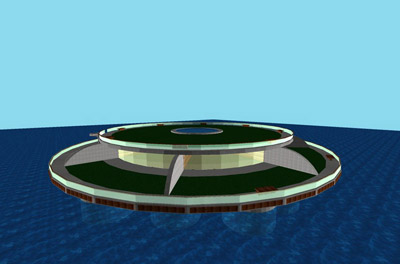
Here we have a design intended to emulate the Aquarius central island look from a very early stage. Based on a 54 meter diameter circular platform built of 52 PSP cells (12 2x2 modules and 4 1x1 modules), it uses a radial layout and would be based on a radial modular panel and slab system. There are 6 residential units of roughly 100 square meters (1000 square feet) of floor area in the single storey structure each converging on a communal atrium lounge. One additional unit is dedicated to utilities and an equivilent space used as an entryway. Planar glass exterior window walls replace conventional windows while glass block may be used to enclose the utilities space and as back walls for the residences. A simple exterior spiral staircase provides access to the roof which is dedicated to garden space and any wind, solar panels, telecom, radar, and marine signalling hardware. This design shows the large skylight of the atrium serving double-duty as a garden pond. This might instead feature a plastic dome skylight.
The key feature of this design is the private lawn space given to each residential unit. Shown divided by arched walls which end at a perimeter walkway, they could also feature walls running right to the platform edge for a higher degree of privacy. This lawn space expands in width for lower level units as the community grows, reflecting the eventual evolution of the structure toward an order of level ring widths and increasing storey heights that would follow some variation of the Fibonacci Sequence.
This and other designs employing a circular base platform would have to employ what I refer to as 'finishing modules' which fill out the stepped rectilinear edges of the cellular platform. The PSP modules themselves are rectangular and aligned in a square packing order. These finishing modules would fit into the rectangular edges and may be highly cantilevered, which limits the amount of load bearing capacity they could handle. Alternatively, the finishing modules could be formed as hollow custom shaped cells the same height as the conventional cells. In any case, these finishing modules could not be reused during expansion of the structure because they are design for a specific arc. As the platform expands, the arc and the interface of the finishing modules would change. This might be less a problem with a PSP platform based on hexagonal rather than square cell packing order but that would require some study because hexagonal packing is higher in density than square packing and thus would reduce the mount of between-cell volume to be used for reserve buoyancy.
Note the perimeter edge 'bumpers' made of wood, recycled polymer lumber, or recycled tire rubber. Though not always shown in my renderings, these are likely to feature in all the designs, allowing for small craft and external module mooring at any point along the perimeter.
ARcondo type 1, stage B:
Here we see the same structure in a later stage of development. The base platform is now 104 meters in diameter and consists of 208 cells. (45 2x2 and 28 1x1 modules) Still a single storey structure, it features 14 residential units of about 130 square meters each (~1400 square feet) and the same two extra spaces for utilites room and entry space. There are also now 6 multi-use internal spaces (the residence spaces of the previous form) surrounding the central atrium lounge, most likely to be used for community services or small shops. A circular interior avenue links all the residential spaces from the back. Front lawn space for the residence units is now roughly doubled. The exterior spiral staircase has now been replaced by a pair of glass block cylinders leading off from the central atrium, one enclosing a spiral staircase and the other a wide pneumatic lift used both for work and for disabled access. Being pneumatic, it can function for emergancy exit of the roof even in the event of a power failure.
Also shown in this image are some possible modular additions to the main community structure including a floating community swimming pull, marina, and concrete fish farming pens all attached to a pair of utility platforms extending off the side of the central platform. The utility platforms will later function as large ship mooring and are shown with shipping containers on their decks used for storage. The swimming pool features a pair of shaded lounge areas covered by perforated aluminum barrel vault canopies. These types of additions would be confined to modular independently floating platforms in order to conserve space on the main structure and to make it easy to expand both work and recreational facilities independent of changes on the main structure. Some of these would eventually be obsolesced by features built into the main structure once the community grows large enough to handle the open sea.
ARcondo type 1, stage C:
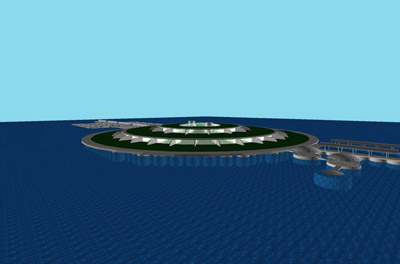
Here the structure has reached an impressive but still relatively small scale, sporting three floors and spanning a diameter of 192 meters. It is looking very much like a miniature Aquarius. There are now 30 residential units of about 166 square meters (~1750-1800 square meters) floor space which can be used either as single or double units depending on the residents' needs. The upper level sports 16 150 square meter spaces used for either residences or for public service and commercial space. In the lower level interior the atrium has been widened and sports 14 150 square meter spaces for shops and community services surrounded by 14 190 square meter spaces used for storage and utilities. This much wider atrium would likely have its original skylight garden pond replaced with a dome by thei point but if a pond can still be supported it would become a major attraction for the community, making this space a popular dining or shopping center for nearby on-shore communities. At this scale the community would most likely be operating in open water, free from the shore but still in a sheltered bay.
We can also see that the external add-ons are now expanded and divided into two wings, one for recreational facilities and the other for transportation and industrial facilities. The public swimming pool is now companioned with a trio of small island floats designed to provide access to the water in the form of a round artificial beach which can be raised and moored tightly to the main structure during inclement weather. Depending on the quality of the water around the community, these could be quite popular and many more of them might be used, perhaps in place of the swimming pool.
ARcondo type 2, stage A:
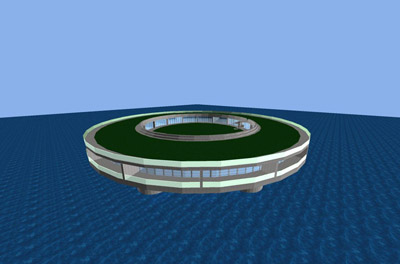
Here is a design variation of the previous type that seeks to offer greater economy of space and structure. The starting size is 68 meters with a platform composed of 88 cells -somewhat larger than the initial size of the previous design but less complex, the savings in construction complexity rolled into more initial space. The functional units are placed at the perimeter of the structure with 'front' lawns replaced by a generous balcony space and creating a large open central area as the primary garden space. Placed at the perimeter, the spaces enjoy a more rectangular layout and thus would make more efficient use of their area. The perimeter roof space would be used primarily for solar panels and high density agriculture. As before, a simple external spiral staircase links the two floors. There are 16 100 square meter spaces used for either residence, community services, or commercial space while, as before, one space is reserved as an entryway and another as a utilities space.
With the inhabited structures at the perimeter one creates a wind barrier that would make the central space quiet and suitable for very dense foliage without an enclosure. In cooler or rainier climates the entire structure could be easily topped in a 'skybreak' dome creating a kind of mini-biosphere structure with a year-round tropical climate. Such a dome would also mimic the appearance of a space habitat, allowing the space development angle to be exploited as a community attraction.
While seeming more conventional to the avergae suburban resident, the practical value of front lawns for an initial community structure is debatable, especially when so much of the surface area is dedicated to garden space. If the community were located in more dense urban areas, bays with somewhat rougher water or higher winds, or in colder climates the use of the lawn space would probably be minimal anyway. Thus this variation might be preferred. The possible use of a skybreak dome would also be a very good way to support a large area PV solar panel array that grows proportionally with the community without sacrificing garden space, the dome employing the recently introduced transparent PV planar panels.
ARcondo type 2, stage B :
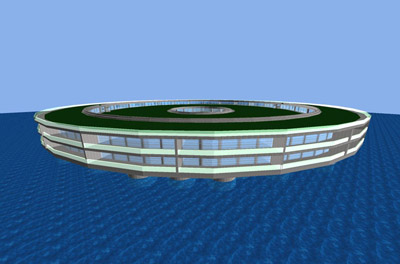
The same structure now much larger. The base platform diameter is 152 meters and the structure has been raised to three storeys. The original atrium space is retained as a sunken atrium in the center of a now very large primary atrium and serves as a public services center or shopping center, using the same unit spaces one used for residences with generous storage and utility space behind them. There are now 48 perimeter residence units of 180 square meters each on two levels. (~200 square meters may be the largest free-span area these radial bay structures will support) The lower level units are enclosed in the back, connected by a circular interior avenue which might also host a personal packet transport system, while the upper level units open to the much enlarged central garden space. These upper and lower units are intended to be combined into single units for family homes, and split in half vertically for smaller two-floor units. In later stages the perimeter may evolve into three storey bays, two storeys facing the garden and three facing the water. In essence, this structure is evolving toward a ring of multi-storey townhouses enclosing a vast circular park. If topped by a skybreak dome, this would be an impressive sight and sets an example for community structures on land and in space. It's possible for such domes to be employed even to the full arcology scale but are likely to be obsolesced should the community ultimately move to equatorial waters.
A possible alternative to the dome would be an 'airfoil' enclosure like that of Richard Roger's Parc Bit community designs which consists of a planar glass curtain which starts at the top roof perimeter edge, arches over the perimeter unit spaces, and then slopes gently to the ground level of the central park. (imagine one of those pre-fab solarium systems enclosing one side of a row of townhouses and sloping to the opposite side of the street) The sloped side would enclose a wide interior avenue, sunken one storey level to open the back of the lower floor level. Terraces on its core-ward side would offer more gardening, bay unit spaces offering some community service locations, and gently sloped ramps leading to the central park. This airfoil enclosure would host solar panels and a powerful ventilation system driven by winds caught under the airfoil shape. Such an airfoil enclosure would not be practical at the start, however, because at a small radius it requires a large number of irregularly shaped segments of planar glass which could not be reused as the structure expands. It would probably require a structure about twice the diameter of the large one illustrated here.
Another virtue of this structural perimeter oriented approach is that it offers rapid support of rough water locations allowing nearer term exploitation of wave power or location in the open sea. This would be done by replacing the lowest level perimeter terraces with a sea wall perforated by heavy watertight windows.
ARcondo type 3, stage A:
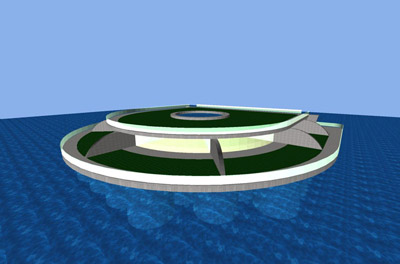
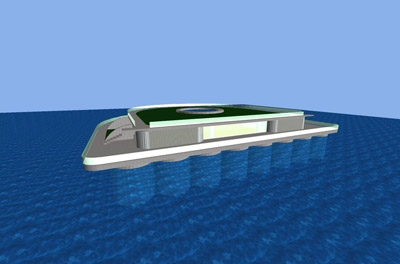
Here we see yet another variation of the first design which is intended to address the problem of mooring a radial community structure at shore. House boats and homes on shore are commonly designed to maximize the views of the water. But radial organized structures moored at shore leave a half of their structure with a less desirable view of the immediate shore. This reduces the sense of privacy and the perceived value of the residential units that face toward the shore. It's rather like having an apartment with a view of an alley. The simplest approach to reducing this problem is to use a structure shaped like a letter 'D'. The flat side would face the shore and unit spaces along it would be confined to utilities and the like while all the units on the curved side enjoy an unobstructed view of the water. The problem with this approach, however, is that as the structure expands its interface along the shore increases in width, being the diameter of what would otherwise be a circle. If the full width of that were touching the shore the amount of onshore real estate for the mooring would increase proportionally. The simple solution to that would be to set the structure just off the shore, connecting it by a narrow marina walkway. This could form the basis of a convenient marina or serve as location for a fish farm. But one can only push that to a certain point. The anchoring of the structure and its increasingly long connecting walkway get increasingly complicated and eventually the width of the structure starts to obstruct the views and water access of pre-existing at-shore buildings and residences. Hopefully, if one took that approach, the community could shift to open water before running into that dilemma.
Condominium barges address this problem by conforming to roughly the same shape of a pier, with a small number of units directly facing the water and the rest offering view parallel to the shore line. This allows direct mooring to the shore but keeps it limits in width and while not all the residences enjoy optimal ocean views, they do retain a water view and a sense of privacy -as long as another such structure isn't built along side. For our expandable community structure this approach offers the potential of extensive incremental expansion outward into the water while still retaining the same direct interface to the shore.
With this design we look at both the 'D' shape approach and the 'pier' shape approach. The initial structure shown is the same size as the Type 1 design and has the same number of residential spaces. However, the 'D' shaped layout affords the residence spaces their unobstructed water views while a pair of utility spaces facing the shore flank a central entrance. This structure could expand in this shape much as the Type 1 structure does, looking like the Type 1 design cut in half. The Type 2 design could also use a 'D' shaped varient and likewise grow in much the same way, though could not use a skybreak dome.
ARcondo type 3, stage b:
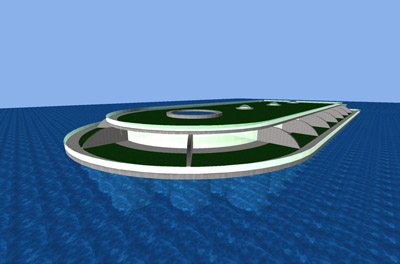
Here we see the evolution of the 'D' shaped structure into a 54 meter wide by 111 meter long 'pier' shaped one. There are 16 residential spaces flanking a wide interior avenue ending at the pond skylight atrium lounge. There are 4 curved units of about 100 square meters each and 12 114 square meter units along the sides. The slab and panel structure is supplemented by interior columns along an interior avenue, supporting a more free-span space. Small domed skylights run along the length, doubling as benches on the roof garden.
An interesting characteristic of this design is its boat-like form which suggests potential for a highly mobile structure. The boat-like appearance might also enhance its public image in the overall coastal community, making it seem less unusual and more consistent with a nautical aesthetic. It is important to note that these structures would have just as much potential to evolve into an arcoliner as they do to evolve into a stationary arcology, both types of habitats employing the same structural and propulsion systems, the arcoliner simply having more azimpods than an arcology needs and power systems not dependent on OTEC.
ARcondo type 3, stage c:
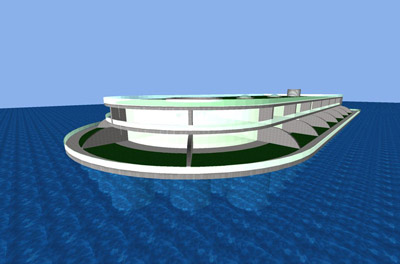
Here is the same structure as before now expanded to simply add a second level of units, effectively doubling the number of units. Upper and lower units could be combined into single residences or used individually. The rear stairs are nor replaced by a glass block cylinder housing a pneumatic lift and surrounded by a spiral staircase. The central avenue is two storey high with the upper level units sporting a terrace running either side of this avenue.
A key limitation of the 'pier' shape is that expansion of its width does not offer much expansion in the number of residence units. Doubling the width of this structure would only increase the width of the interior area, the width of the rooftop garden, and the number of curved unit spaces on the end. The number of side spaces would remain the same. They could be made deeper but would rely more on artificial light or the use of light pipes or optic fiber light collectors. So it is more likely that growth would be done by increasing the height as well as the length more than the width. In later stages this structure might grow to three storeys high with perhaps a slope at the water-facing end to create a stepped terrace look. The lower level spaces might be converted into a shopping plaza. The back end of the structure could support an arched glass roof overhanging the garden space, allowing the interior avenue to be opened up to admit more light and adding a more novel looking design style and a place for integral PV panels.
The 'pier' shape may also encounter complications in conversion to a radial form when relocated to open water. Most likely, the relocated structure would replace the back structure with a duplicate rounded end like the front structure then flare out on its sides until assuming a square or radial form.
ARcondo type 4, stage A :
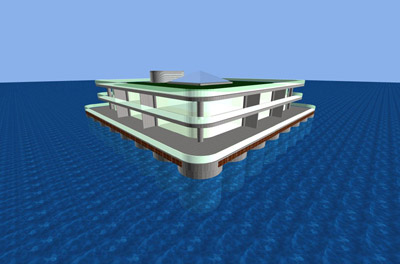
Here we see a design that seeks to economize on initial construction cost by conforming to the natural rectilinear form of the PSP modules and using simple slab and column based components. Starting with a 48 meter base platform composed of 16 2x2 cell modules and a two storey structure, the simple building offers 12 multi-use units, 2 utility units, and a two storey glass pyramid topped central atrium lounge each with a generous 144 square meter (1500 square feet) area. Additional space can be gained for individual units by extending the glass walls outward, enclosing the outside terrace space. Units can also be combined into single split-level units. The rooftop garden features a whopping 1750 square meters of contiguous area, minus the space of the atrium's pyramid. Partition walls are non-load-bearing and based on mineral foam panel to provide a highly effective firebreak and high sound insulation. These might be clad in wood panels, particularly along the exterior portions, to soften the look of the concrete. Spanning the entrance space, a glass block silo features opposing spiral stairs and pneumatic lift.
Many would consider this structure to appear too much like an office building but by conforming to this rectilinear shape the structure enjoys much greater efficiency of space and lower construction costs and residents can enjoy easier layouts for their loft units because they are simple squares. The corner units have a superior view and larger amounts of exterior terrace space which may make them more valuable. They would also be better suited for some community service uses like restaurants and exercise rooms.
This structure could be readily expanded either as an increasingly large square of increasing storey height or extended into a rectangular to assume a 'pier' shaped structure.
Arcondo type 4, stage B:
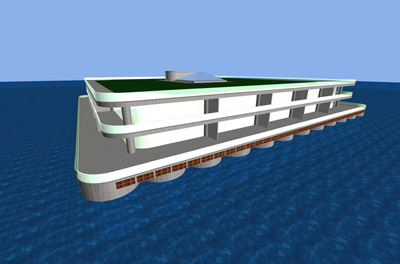
Here we see the structure as a much larger square building on a 72 meter wide platform. It now sports 28-30 multi-use units and a 4350 square meter garden level. At this stage the community might choose to isolate the lower levels from the upper levels to establish a commercial center at the bottom with residences and the atrium lounge confined to the upper level. In that case the perimeter walkway on the lower level might serve as a public thoroughfare.
As this structure increases in area a considerable amount of interior space would be blocked from direct access to sunlight. This would become a problem at some point for all variations of these terraced concrete structures no matter what their design. It would be impractical to create many skylights as it would sacrifice contiguous garden space. So instead a likely alternative would be to use light pipes along the perimeter and running between partition walls or a system of fiber optic lighting fed by Himawari (Sunflower) light collectors. These would be located on the roof of the stair and lift silo or the corners of the garden level, along with solar panels and other surface mount equipment.
ARcondo type 4, stage C:
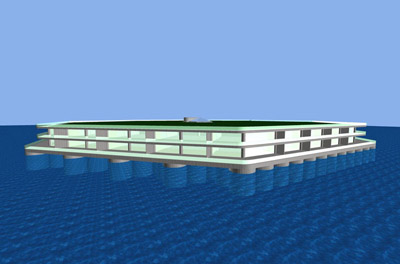
We now see this structure evolving toward a form similar to the Type 1 design by changing from a square to an octagon 168 meters wide. It features 64 perimeter multi-use units in three different floor space sizes; 144, 216, and 288 square meters. The interior atrium still uses the same skylight pyramid but has been expanded in area and hosts 11 unit spaces for shops or other community service uses. This might also be expanded to 22 spaces if the atrium is allowed to use two floors. There are also 4 or 8 satellite lounge spaces around this atrium and a great number of interior spaces for utilities and other uses.
The structure would continue to become rounder in successive stages but because it uses a square grid of columns and slabs it would not have the uniform layout of the radial panel and slab system employed in the Type 1 design. Instead, it would employ a square inner column grid rounded out by a more irregular perimeter column grid or a light radial panel and slab system with the panels reusable but the slabs customized to a given perimeter form. This would present a greater diversity among perimeter unit sizes and layouts.
Such a structural approach is likely in the full scale Aquarius structure. A rectilinear structural grid in the interior simplifies the engineering of the overall structure and in the interior where heavier top loads would be the norm. It also reduces the structural masses in the interior, supporting greater structure heights with less need to replace underlying float modules. At the same time, using irregular column or panel placemeant and variably formed slabs at the perimeter where much lower loads capacities are needed affords greater architectural diversity. Such hybrid structural approaches would be easier to support with monolithic construction, hence the tendency for the community to evolve toward use of that method in the long run.
ARcondo type 5, stage A:
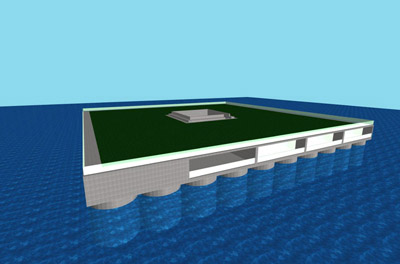
In this final design we see an approach focussed on achieving the maximum economy in construction cost and the maximum usable top-surface garden space area. Unlike the previous designs, this one uses prefabricated bay units matched exactly to the size of 2x2 cell modules and, in fact, it would be possible for PSPs and these building bays to be combined as a single monolithic unit suited to mass prefab construction. This use of bay modules derives from Float Inc.'s own suggested approach to platform development.
The platform is a simple unadorned 10x10 cell 60 meter wide square with open ended bay units stacked in a 5x5 array. The bays are organized to provide three 144 square meter multi-use perimeter units on each side plus a 12 meter wide corridor running through the interior. This corridor is rather large for a residential complex but would make industrial uses much easier. A 144 square meter open topped atrium lounge is featured in the center, sporting a simple staircase and 4 bays for community service uses. Not shown in this illustration, the perimeter units could feature cantilevered balcony decks with folding supports attached to the sides of the bays. These would be designed to quickly fold up like a drawbridge to completely enclose the front of the bay units in the event of severe weather. The other types of designs would rely on removable modular steel panels or rolling storm shutter systems for the same purpose.
This design is very austere in appearance but, for those of a modernist bent, it could be quite attractive. (I personally find it quite nice because the structure is so simple it practically disappears from one's perception. The roof top foliage and the surrounding environment would completey dominate its appearance) The very generous amounts of space and perfectly square unit spaces would make for very comfortable loft homes. I suspect, though, that this design would more likely be used by platforms with an industrial or military focus and thus could be the basis of turnkey platform construction packages. This design would also well suit the application of hybrid off-shore energy platforms and reservoir based evaporation reduction structures as recently discussed, in the latter case the PSP cells being replaced by a simple open bottom square static float.
This type of structure could expand in all the ways the previous designs would except that it would be limited to a stepped edge, these large bay modules not allowing the support of curving or diagonal perimeter shapes. It could also employ the perimeter structure focused approach of the Type 2 design but using rectalinear shapes. As plain as it look, it has a lot going for it, though ultimately the use of these large modular bays would be obsolesced by more architecturally flexible building systems.
ARcondo type 5, stage B:
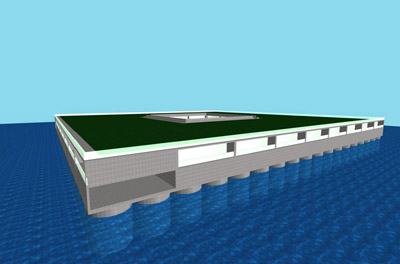
Here is the same structure now expanded and equipped to support open ocean or rough water locations. There are 32 multi-use perimeter units, an expanded central atrium with 12 bays for shops or other uses, and a truly massive amount of interior utility and storage space.
This and all the previous designs would have to be raised to at least two storeys above the water surface with the lower storey dedicated to a seawall like function when they reach the stage of open sea location, though they might disguise this seawall level in various way, using deployable terrace structures or simulated beach structures. Here, with this minimum cost design approach, the perimeter is a simple sea wall that encloses a base channel structure used for storage and utilities, housing for wave power systems and systems supporting the azimpod station keeping thrusters, and which has a perimeter channel with possible closable sea wall doors used for access to walkways to the shore, for vehicle transfers, and as a garage for light boats or wheeled vehicles. There might also be perimeter compartments for life boats if regional regulations demand it. Later on this lower level would enclose the community PRT and PPT systems as well as the hardware for OTEC plants.
In later stages of this design's evolution the single floor unit bays would be replaced by double, triple, and then quad floor cubic bay units which use retrofit decking for interior floor divisions. This would be done to reduce the top load mass, to support industrial equipment of variable height, and to accommodate the community's eventual evolution to an arcology-style cell division. At some point, though, the use of modular bays would have to be abandoned in favor of other structural systems in order to accommodate evolution into an Aquarius-style form.
Other designs and the ultimate form:
As we can see, with the PSP and these simple structural systems we have a great degree of design freedom with many other seed structure designs possible. They can be as simple or as elaborate as residents might desire. Many more variation might be possible with the use of PSP cell modules of different geometries, particularly hexagonal ones, though they would be limited to a much larger minimum 7 cell unit. My designs have focussed on the use of modular components at the start for sake of economy but if one were to use monolithic construction from the start the architectural options would greatly increase offering even more variation in design but at the cost of more expensive expansion. It is even possible to employ free-form organic architecture using ferrocement construction, variable sized and shaped PSP cells, and a layout that mimics natural island forms, producing a community structure akin to the fanciful landscapes of Chinese paintings. That might be worth considering if one had the artistic talent and manpower available, though the amount of demolition and reconstruction that would require during expansion would be considerable and costs could only be ameliorated by more exotic alternatives to conventional cement that offer direct recycling, such as ceramicrete.
As I've noted previously, all these possible seed structure designs would ultimately evolve into more or less the same type of megastructure similar to the design of Marshal Savage's Aquarius. What I mean by this is not a structure exactly like the Aquarius seen in TMP but rather similar to it in that it is organized into a terraced mountain-like superstructure where all inhabited spaces are concentrated at the perimeters of terraces with terrace-top space used exclusively for recreation, farming, and parkland. Savage's cellular structural design was more metaphorical than practical. There are no particular functional virtues to a structure based on massive uniform hexagonal megacells. Instead, I foresee the actual structure being what I refer to as a 'contour terrace' megatructure where the height, width, and shape of terrace edges are freely articulated to simulate different shapes and naturalistic landscapes in the manner of lines on a topographic contour map. Have you ever seen pictures of the terraced mountain farmlands of South America and Asia? That's what I'm talking about here. PSPs elilminate the need for strictly symmetrical platform shapes and thus it is likely that the marine colonies based on this structural system will employ an inifnite variety of forms where terrace edges are articulated -shaped into convex and concave forms- with endless variety to suit innumerable different styles of architecture. We will leave the possible designs for full scale colonies to another project.
Conclusion:
Looking at these many different seed structure designs we can see that there is a lot of potential in this alternative approach to AR, allowing all coastal areas around the globe to potentially serve as the starting point of marine colonies evolving from any number of different patterns of community development. And even with the objective of arcology development aside, these simple structures would have much potential in the markets for house boat and condominium barge real estate, condoliners, commercial waterfront development, and for marine military and industrial facilities. If that's not 'bankable' I don't know what is. Clearly, there is no reason to think about Aquarius as a fanciful science fiction dream. Creating Aquarius is just streightforward real estate development that can be based on exactly the same economics of real estate development on land.